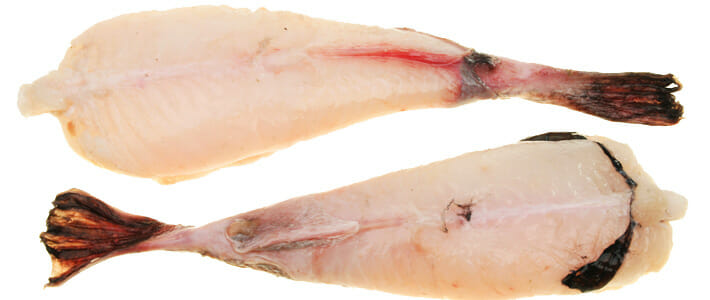Monkfish

Monkfish (also known as Headfish, Goosefish, Monktails, Angler, Fishing frog, Allmouth, Molligut, Abbot, Sea-devil, Lotte) is the English name of a number of types of fish in the northwest Atlantic. The term is also occasionally used for a European “sea monster” more often called a sea monk. Monkfish are described as mostly mouth with a tail attached because they have very broad heads and large mouths. Monkfish are capable of eating prey as long or longer than themselves. Monkfish are opportunistic feeders, feeding on whatever prey is available at the time. Adults mainly eat fish, including other monkfish, but also consume crustaceans, mollusks, seabirds, and diving ducks. Larvae feed on zooplankton (tiny floating animals); juveniles eat mostly small fish including sand lance, as well as shrimp and squid.
Product pdf for download-
3.5 ounces of raw, edible portions
-
Calories 76
-
Total Fat 1.52g
-
Saturated Fat 0.34g
-
Selenium 36.5mcg
-
Cholesterol 25mg
-
Sodium 18mg
-
Carbohydrates 0g
-
Protein 14.48g
Spawning Method
February through October, progressing from south to north.
Flavor & Texture
The only edible portions of the monkfish are its muscular tail and its liver. The tail meat of the monkfish is delicious: dense, sweet, and very similar to lobster tail meat in both flavor and texture. Monkfish liver is quite popular in Japanese cuisine, usually served as sashimi.
Preparation
Monkfish, is best cooked with some moisture. It’s fine roasted — if you roast it long enough — and it’s good grilled. But in both cases it’s got a tough texture that can be a turnoff. Monkfish has been called the “veal of the sea” and cut into thin medallions, breaded and sauted; the toughness disappears and the fish works well in a variety of preparations. But braised, it also becomes tender, fairly quickly.
Market Segments
Fine dining.
Nutritional Facts
Monkfish is low in sodium and is a good source of niacin, vitamins B6 and B12, and potassium and a very good source of protein, phosphorus, and selenium.
Other Information
The monkfish resource is healthy and is harvested at sustainable levels. Managers established a rebuilding plan for monkfish since 1999, implementing strict management measures to improve the health of the monkfish resource. Monkfish has since been declared rebuilt.
Interesting Fact
There is currently no commercial aquaculture of monkfish in the Uned States.
Source
Monkfish live on the ocean bottom, typically on sand, mud, and shell habitats. They can tolerate a wide range of temperatures and depths from inshore up to at least 2,950 feet deep. Found in the Northwest Atlantic Ocean, from the Grand Banks and northern Gulf of St. Lawrence south to Cape Hatteras, North Carolina.
Harvest Method
Monkfish are primarily caught with bottom trawls and gillnets.
Alternatives
No true alternatives for monkfish.